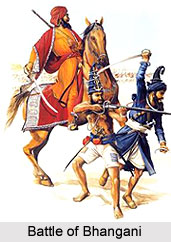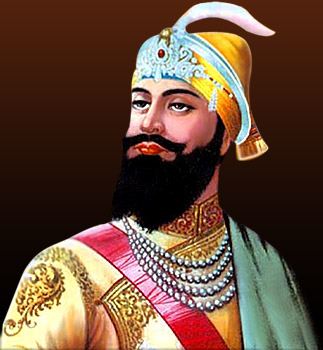 Bhim Chand`s son was to get married with the daughter of Raja Fateh Shah of Garhwal. They along with Kirpal Chand of Kangra, Sidh Sain of Mandi and some more hill rajas planned to attack Guru Gobind Singh`s camp. They drove away the 500 Pathans who worked under the Guru. The Guru requested Pir Buddhu Shah for help who immediately sent seven hundred of his men under the command of his four sons to assist the Guru. The enemy force moved forward crossing the Yamuna River, a few miles ahead of Paonta Sahib to meet the Sikhs. Guru Gobind Singh was well aware of the entire area hence he planned to fight the hill army in the valley of Bhangani. He occupied a small hillock facing the field of battle. He kept some of his army behind the hillock to be brought into operation when required.
Bhim Chand`s son was to get married with the daughter of Raja Fateh Shah of Garhwal. They along with Kirpal Chand of Kangra, Sidh Sain of Mandi and some more hill rajas planned to attack Guru Gobind Singh`s camp. They drove away the 500 Pathans who worked under the Guru. The Guru requested Pir Buddhu Shah for help who immediately sent seven hundred of his men under the command of his four sons to assist the Guru. The enemy force moved forward crossing the Yamuna River, a few miles ahead of Paonta Sahib to meet the Sikhs. Guru Gobind Singh was well aware of the entire area hence he planned to fight the hill army in the valley of Bhangani. He occupied a small hillock facing the field of battle. He kept some of his army behind the hillock to be brought into operation when required.
The Guru was left in a weak position at this point of time as a large number of army men left him before the battle. The Pathans, who were well ware of the Guru`s resources hence they too changed sides and joined hands with Fateh Shah. The Guru had a nominal force but with his marvellous war tactics the Guru along with his army defeated the overwhelmingly larger enemy. The Guru made plans to fight Fateh Shah on the banks of the rivulet Gir at Bhangani located about 10 miles north of Paonta. He instructed Medni Parkash and Buddhu Shah of Sadhaura to march to Bhangani. He then occupied a hillock to attack the Garhwali army. The bulk of the Guru`s troops remained hidden behind the hillock.
 The Garhwalis were now joined by the Pathans who had deserted the Guru. The Guru put a major part of his army in the attack against the Pathans. The Sikh army were defeated. During the evening hours the Guru himself plunged into the battle and killed Hari Chand. This incident terrorised the enemies and Fateh Shah and his men fled away. Thus the Sikh army emerged victorious. The Guru along with his victorious army marched towards Sadhaura and from there he sent the soldiers to Makhowal.
The Garhwalis were now joined by the Pathans who had deserted the Guru. The Guru put a major part of his army in the attack against the Pathans. The Sikh army were defeated. During the evening hours the Guru himself plunged into the battle and killed Hari Chand. This incident terrorised the enemies and Fateh Shah and his men fled away. Thus the Sikh army emerged victorious. The Guru along with his victorious army marched towards Sadhaura and from there he sent the soldiers to Makhowal.
Guru Gobing Sigh`s headquarters lay between two rival states. Fateh Shah decided to occupy all territories which were disputed between Medni Parkash and himself. Thus, to attain his goal the Guru was required to be dislodged from Paonta.
He shifted to Ramgarh and met the Rani of Raipur. He then entered into an agreement with Bhim Chand and was back in Anandpur in 1688. Guru Gobind Singh too decided to leave Paonta and go back to Anandpur. He raised his camp in November 1688 and sent most of his army to Anandpur. With a small force he moved leisurely stopping at Kapalmochan and Sadhaura. He also stayed at Naraingarh, Raipur Rani. Finally he returned to Anandpur via Ropar and Kiratpur. He built a chain of forts around Anandpur and garrisoned them with trained musket men and mounted two guns, viz., Bhangani (Tigress) and Vijay Ghosh (an announcer of victory) on the fort walls.




















